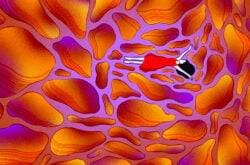Illustration: Nhung Lê
The Locrian mode is one of the seven common diatonic modes.
Generally considered the darkest of these modes, the Locrian mode possesses a unique sound that has been used in a surprisingly wide array of musical contexts. In this article, let’s discuss what exactly the Locrian mode is, some popular compositions that make use of it, and how to apply it to your own music.
Feel free to use the table of contents below to quickly navigate to a specific section.
What you’ll learn:
- What is the Locrian mode?
- Locrian mode intervals
- The Locrian scale in all “keys”
- Songs that use the Locrian mode
- How to use the Locrian mode in your music
Let’s get started!
What is the Locrian mode?
The Locrian mode is a mode that contains all of the notes of natural minor, but with two key differences: a flattened second (♭ˆ2) and flattened fifth (♭ˆ5). If we started on B, then its ascending scale would consist of B, C, D, E, F, G, A, and B.

The B Locrian scale
What’s the difference between the Locrian and Super Locrian scales?
When exploring the Locrian scale, you may also come across the Super Locrian scale, which is like Locrian, but with the fourth also flattened. This scale is also referred to as the Altered Scale because it essentially alters all of the notes of a major scale.

The B Super Locrian scale
The history of the Locrian mode
The Locrian mode gets its name from those who lived in the ancient Greek regions of Locris, where it was believed to have originated. Compared to the other diatonic modes, it was used more sparsely throughout history, due to its perceived dissonance and instability.
Today, the Locrian mode has found increased use in genres including jazz, rock, and metal. It’s also commonly featured in film and video game soundtracks to heighten feelings of tension and suspense.
Locrian mode intervals
As you can decipher from the previous example, the Locrian mode consists of the following intervals:
- Root
- Minor second
- Minor third
- Perfect fourth
- Diminished fifth
- Minor sixth
- Minor seventh
If you were to sequence an ascending scale, the intervals could be expressed in shorthand as HWWHWWW (‘half whole whole, half whole whole whole’).
Applying this formula, here would be the notes for a C Locrian scale:
- C
- D♭
- E♭
- F
- G♭
- A♭
- B♭
- C

Transposing it to D, here are the notes for an D Locrian scale:
- D
- E♭
- F
- G
- A♭
- B♭
- C
- D

Once you familiarize yourself with the pattern, you can apply it to construct a Locrian scale off of any other root note. While there are many possible shapes, if you’re a guitarist, you can also refer to the following tablature for a transposable scale:

Guitar tabs for a D Locrian scale
The Locrian scale in all “keys”
While familiarizing yourself with the sequence of intervals is far more valuable (and easier) than memorizing every scale one-by-one, here’s a table outlining the Locrian scale associated with every root note for easy reference:
| Root | Notes in the Locrian scale |
| C | C – D♭ – E♭ – F – G♭ – A♭ – B♭ – C |
| C♯ | C♯ – D – E – F♯ – G – A – B – C♯ |
| D♭ | D♭ – E♭♭ – F♭ – G♭ – A♭♭ – B♭♭ – C♭ – D♭ |
| D | D – E♭ – F – G – A♭ – B♭ – C – D |
| D♯ | D♯ – E – F♯ – G♯ – A – B – C♯ – D♯ |
| E♭ | E♭ – F♭ – G♭ – A♭ – B♭♭ – C♭ – D♭ – E♭ |
| E | E – F – G – A – B♭ – C – D – E |
| F | F – G♭ – A♭ – B♭ – C♭ – D♭ – E♭ – F |
| F♯ | F♯ – G – A – B – C – D – E – F♯ |
| G♭ | G♭ – A♭♭ – B♭♭ – C♭ – D♭♭ – E♭♭ – F♭ – G♭ |
| G | G – A♭ – B♭ – C – D♭ – E♭ – F – G |
| G♯ | G♯ – A – B – C♯ – D – E – F♯ – G♯ |
| A♭ | A♭ – B♭♭ – C♭ – D♭ – E♭♭ – F♭ – G♭ – A♭ |
| A | A – B♭ – C – D – E♭ – F – G – A |
| A♯ | A♯ – B – C♯ – D♯ – E – F♯ – G♯ – A♯ |
| B♭ | B♭ – C♭ – D♭ – E♭ – F♭ – G♭ – A♭ – B♭ |
| B | B – C – D – E – F – G – A – B |
As we mentioned in our article on the Phrygian mode, we use the term “key” loosely to refer to these because modes don’t follow the same functional behaviors of traditional major and minor keys, which are a requisite of the term in its strictest definition. Also note that several of these are enharmonically equivalent—for example, the modes built off of A♯ and B♭ share all of the same pitches, but are simply expressed differently in writing.
Songs that use the Locrian mode
While scales are a necessary starting point, they don’t paint a full picture of the Locrian mode’s sound by themselves. Let’s begin to familiarize ourselves with the mode by listening to a few pieces of music from varying genres and contexts that feature its sound.
1. “Army of Me” by Björk (1995)
A rare example of a pop song that features the Locrian mode is Björk’s “Army of Me.” The gritty bassline features the flattened fifth, and the vocal heavily emphasizes the flattened second—the two pitches that are central elements in defining the mode. Here, the Locrian sound is used to create a chaotic feeling that wonderfully juxtaposes Björk’s flowing but calculated vocal delivery.
2. “Dust to Dust” by John Kirkpatrick (2001)
“Dust to Dust” is another rare use of the Locrian mode, this time in folk music. While still establishing an overall dark sound, the mode sounds quite melodic here; by keeping the instrumentation in unison with the vocal melody, Kirkpatrick is able to access a Locrian sound while avoiding emphasizing the simultaneous sounding of tense intervals, such as tritones and minor seconds.
3. “At Doom’s Gate” by Mick Gordon (from Doom) (2016)
Last but certainly not least, “At Doom’s Gate” from Mick Gordon’s celebrated Doom soundtrack captures what many of us may naturally expect when thinking of the Locrian mode. Combined with the heavy instrumentation and production, the Locrian guitar riff maximizes the music’s intensity in a way that simply wouldn’t have been possible with natural minor.
When to use the Locrian mode
There are no hard rules for when and how to use the Locrian mode in your own music. That said, if you want to experiment with it but aren’t sure where to start, below we’ve highlighted a few ideas that you can try out to develop your own unique applications and associations.
1. Introduce a dark sound to your music
In our discussions of other modes, we’ve generally emphasized how each mode can be used to achieve a wide range of emotions and moods. That said, as heard in the examples above, the Locrian mode is overwhelmingly used to create some shade of darkness or tension. A major reason for this is the Locrian mode’s unique trait of having a diminished root chord, which features one of Western music’s most inherently unstable intervals in the tritone.
With that, if you’re looking to introduce some instability or chaos in your music, the Locrian mode is a great musical palette to reach for. That said, an interesting compositional exercise could also be to flip that expectation on its head, experimenting with ways to make the mode sound delicate or vulnerable.
2. Capture the listener’s attention
Because diminished chords and tritones are rarely heard in popular music, the Locrian mode does a great job at grabbing the listener’s attention. Whether you’re soloing on your guitar or composing an orchestral score, if you’re looking to catch your audience by surprise, consider introducing a moment of Locrian color before pivoting back to major, minor, or perhaps even a different mode of your choosing.
3. Write memorable motifs
Last but not least, if you’re creating a soundtrack for film or video games, the Locrian mode can be a great tool for establishing memorable motifs due to its inherently unique sound. Villains and enemies will likely be the natural go-to for Locrian associations, but it could be interesting to venture outside of this box too.
Conclusion
Though seldom used, the Locrian mode provides a highly unique color that’s great to be aware of when it comes to developing your compositional toolkit. Hopefully this article gave you a foundation for how it’s structured, and provided you with some initial ideas for using it that you can apply to create your own unique musical settings.
Do you have any questions around using modes in your music? What other topics in music theory would you like to see us cover next? Start a conversation with us and other music creators via the Splice Discord.
Continue your exploration of modes in music:
June 18, 2023



